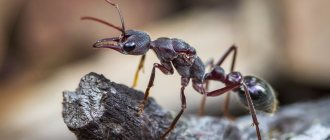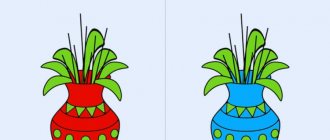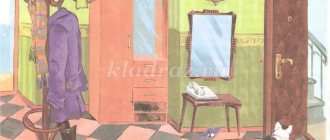Abstract of GCD on ecology in the senior group on the topic: Virtual excursion to the meadow
Ecology in the senior group. GCD
Abstract of GCD on ecology in the senior group. Virtual excursion to the meadow
Author: Irina Pavlovna Zholobova, teacher at MBDOU No. 22.
Goal: To form children’s ideas about the meadow. Program content: - to activate children’s ideas about the diversity of living organisms in the meadow; - continue to learn how to use a microscope; — teach children to compare different objects viewed under a microscope; - develop curiosity and attention; - develop interest in research, children’s interest in nature; - activate children's vocabulary with the following words and expressions: microscope, lens, eyepiece, stage, cells. Integration of educational areas: Speech development. Social and communicative development. Cognitive and research development. Preliminary work: Conversation about the meadow. Reading poems about the meadow, asking riddles about the plants of the meadow. A conversation about the purpose of a microscope, an examination of the components of a microscope, a conversation about the rules for using a microscope, an examination of onion skin cells and a butterfly wing. Materials and equipment: pictures of insects (mosquito, butterfly, bumblebee, bee), pictures of flowers (chamomile, dandelion, clover, bell), tables with images of insects and flowers visible under a microscope and numbers, corresponding riddles, glass slides with fragments of insects and plants, microscopes, presentation, picture meadow, number axes, pencils.
Move
- Guys, I know you are inquisitive!
You know how to solve riddles. (slide 1) Mom gave birth to a daughter From a beautiful flower. Nice, little one! The baby was an inch tall. If you've read the fairy tale, you know what the daughter's name was. (Thumbelina) Thumbelina invites you on an excursion to the meadow. (slide 2) - Let's say the magic words: “One, two, three, spin around. Find yourself in the meadow!” A path runs through the meadow, dives to the left, to the right. Everywhere you look there are flowers around, and knee-deep grass. I. Surikov “In the meadow” - Guys, we have come to the meadow. (slide 3) Have you been to a meadow or clearing? What plants grow in the meadow? Who lives there? Thumbelina is very smart and clever, she loves to ask riddles. Why does she have such a name? (answers) That's right, she is very small, her height is only 2.5 cm, and the riddles she prepared are just as small. Therefore, to see them we need a microscope. (Children sit at tables in pairs) Rules! Let's remember the safety rules: 1. Handle the slide carefully, only by the edges. 2. Place it on the microscope stage, 3. Set the desired magnification, 4. Turn on the light (I-lower light, II-upper light) 5. Focus with the screw and examine. - You are ready? Begin! Here's your first riddle: 1. A fashionista in a bright dress - a huntress for a walk. It flutters from flower to flower, When it gets tired, it rests... (butterfly) Examine slide No. 1, what could it be? (slide No. 4) I suggest keeping an observation diary in the form of a table. Consider it. After each riddle, record the results using pictures. 2. Like a nail on a magnet, It rushes at us - It rings without bells, It bites without teeth. (Mosquito) Remove glass No. 1, put glass No. 2. What does it look like? A mosquito's foot... (Slide No. 5) - Don't forget to mark the guessing pictures in the table! 3. Early in the morning she can’t sleep. She really wants to work. So the hard worker brought honey... (bee) Remove glass No. 2, put glass No. 3. Did you find out what it is? Bee head! (Slide No. 6) Thumbelina offers to complete the task and help the bee. During the day, the bee collected 12 buckets of nectar. How many honeycombs will be filled if one honeycomb contains two buckets of nectar? Take and place a number line and a pencil in front of you. Mark on it with a dot how many buckets of nectar the bee collected. One division is one bucket. Who remembers how many buckets are included in one cell? Since we will mark the bucket with an arc? Two at a time... how many did you get? - Well done! Physical exercise And now let's play a game: “In the meadow in the morning” In the meadow in the morning, we started a game: (Children are sitting) You are a daisy, I am a bindweed. Join our circle. (Hold hands and form a circle) One, two, three, four. Spread the circle wider. (Walking in a circle) And now we are streams, Let's run in a race. (Running in a circle) We hurry straight to the lake, (Closing in a circle) The lake will become big. (We make a big circle) All nature has blossomed in a wondrous color. Thank you, mother earth!!! (Children bow) We rested, frolicked and returned to our place. 4. It grows everywhere in the summer - In the field and near the hummocks. It is elegant, purple, It is... (Bell) Remove glass No. 3, put glass No. 4. What does it look like? Bell petal. (slide number 7) 5. The leaf is a trefoil, like a fan. A thin flexible stem, a red cap - a flower. The juice in those flowers is sweet, The bumblebee flies after it on (... clover) Remove glass No. 4, put glass No. 5 What does it look like? Clover petal. (slide No. 8) 6. Yellow eyes with white eyelashes, for the joy of people, bees and birds. They decorate the earth with themselves, Sometimes they tell fortunes on their petals Butterflies love them, insects love These flowers are called... (daisies) Remove glass No. 5, put glass No. 6 Did you know what it is? Chamomile petal. (slide No. 9) - Don’t forget to mark the guessing pictures in the table! 7. A golden lantern burned in the dewy grass. Then it faded, went out and turned into fluff. (dandelion) Replace glass No. 6 with glass No. 7 Did you find out what it is? This is a dandelion seed. (slide number 10) - Guys, all these plants are medicinal. Tell me, what does medicinal mean? Well done! Thumbelina offers to complete the task and help her place flowers in the meadow. Place a picture of a meadow in front of you and listen carefully! Plant a dandelion in the upper right corner. There is a bell in the lower left corner. Plant clover in the lower right corner. In the upper left corner - a chamomile. Place a bumblebee in the center. - How does a bumblebee buzz? Name words with the sound “Zh”. — Do you think bumblebees bite or sting? New information. Bumblebees are very peaceful; they can sting when defending their nest, or if they have been harmed.
Unlike a bee's, the bumblebee's sting is not jagged, it is smooth, so they can sting several times. Advice from Thumbelina! To avoid being a victim of a stinging insect, you need to follow several recommendations: do not wave your arms when you see an insect, do not remove it from yourself if it lands on you, do not climb into its nest. Then he definitely won’t touch you, since he is a non-aggressive insect. Well done today! -Guys, our trip to the meadow is over. In parting with the meadow, I would like to tell you: “Children, take care of the meadow, herbs and flowers. It’s impossible to live in the world without this beauty.” - It's time for us to return to the group. Let's say the magic words: “One, two, three, spin around. Find yourself in your group” “If I pick a flower” If I pick a flower, If you pick a flower, If everyone: both me and you, If we pick flowers, All the meadows will be empty And there will be no beauty! (Tim Sobakin) Presentation on the topic: Virtual excursion to the meadow
We recommend watching:
Abstract of GCD in the senior group on familiarization with the outside world on the topic: Winter Summary of GCD on cognitive development in the senior group on the topic: Fluttering flowers GCD on ecology in the senior group GCD on environmental education of children of senior preschool age
Similar articles:
Abstract of GCD in the senior group on cognition on the topic “Furniture Factory”
Abstract of educational activities for cognition in the senior group of kindergarten on the topic “Russian folk toys”
Summary of a lesson on cognition in the senior group of kindergarten on the topic: Hearing organs
Conversation in the senior group of kindergarten on the topic: What are fabrics for?
Summary of a lesson on cognition in the senior group on the topic: My city Voronezh




